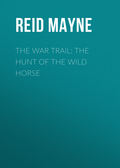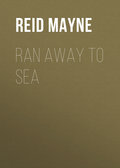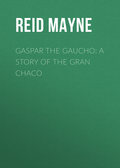
Майн Рид
Popular Adventure Tales
CHAPTER XL.
ADVENTURE WITH AN ANACONDA
For several days they voyaged down-stream, without any occurrence of particular interest. Once or twice they saw Indians upon the shore; but these, instead of putting off in their canoes, seemed frightened at so large a craft, and remained by their “maloccas,” or great village-houses, in each of which several families live together. Not caring to have any dealings with them, our travellers were only too glad to get past without molestation; and, therefore, when they passed any place where they thought they observed the signs of Indians on the bank, they kept on for hours after, without stopping.
A curious incident occurred one evening as they were bringing the balza to her moorings, which compelled them to drop a little farther down-stream, and, in fact, almost obliged them to float all night, which would have been a dangerous matter, as the current at the place happened to be sharp and rapid.
They had been on the look-out for some time for a good camping-place, as it was their usual hour to stop. No opening, however, appeared for several miles. The banks on both sides were thickly-wooded to the river's edge, and the branches of the trees even drooped into the water. At length they came in sight of a natural raft that had been formed by driftwood in a bend of the stream; and as the logs lay thickly together, and even piled upon each other, it appeared an excellent place to encamp on. It was, at all events, better than to attempt to penetrate the thick jungles which met them everywhere else; and so the balza was directed towards the raft, and soon floated alongside it.
They had already got ashore on the raft, which was dry and firm, and would have served their purpose well enough; when, all at once, Guapo was heard uttering one of those exclamations, which showed that all was not right. The rest looked towards him for an explanation. He was standing by the edge of the floating timber, just where the balza touched it, with his arms stretched out in an attitude that betokened trouble. They all ran up. They saw what was the matter at a glance. Thousands of red ants were climbing from the raft to the balza! Thousands, – nay, it would be nearer the truth to say millions!
At one glance Don Pablo saw that it would be a terrible calamity, should these creatures gain a lodgment on the balza. Not only were they the dreaded stinging ants, but in a short time nothing on board would be left. In a few hours they would have eaten all his stores, – his bark, his vanilla, and his roots. Already quite a number had got upon the canoe, and were crossing it toward the body of the balza.
Without saying another word, he ordered all to get on board as quickly as possible, each taking some utensil that had already been carried on shore. He and Guapo flew to the poles; and, having hastily unfastened and drawn in the cable, they pushed the balza out into the stream. Then while Guapo managed the great oar, Don Pablo, assisted by Leon and by Doña Isidora, went to work with scoops and pails, dashing water upon the ants; until every one of them had disappeared, drowned in the canoe or washed off into the river. Fortunate for them, they had observed this strange enemy in time. Had they not done so – in other words, had they gone to sleep, leaving the balza where it was during the night – they would have awakened in the morning to find their stores completely destroyed, their labour of a year brought to nothing in the space of a single night. This is no uncommon occurrence to the merchant or the colonist of tropical America.
They had made a narrow escape, but a fortunate one. They were not without their troubles, however. No open ground could be found for miles below; and, as it was growing dark, they approached the thickly-wooded bank; and, after a good deal of scratching among the branches, at length succeeded in making the cable fast to a tree. The balza then swung round, and floated at the end of the cable, half of it being buried under the long hanging branches.
They spent their night on board, for it was no use attempting to to get on shore through the underwood; and even if they had, they could not have encamped very comfortably in a thicket. On the other hand, the balza did not afford the best accommodation for sleeping. The little “toldo,” or cabin, was not large enough to swing a hammock in. It would only contain a few persons seated close together; and it had been built more for the purpose of keeping the sun off during the hot hours of the day than for sleeping in. The rest of the balza was occupied with the freight; and this was so arranged with sloping sides, thatched with the bussu-leaves, that there was no level place where one could repose upon it. The night, therefore, was passed without very much sleep having been obtained by any one of the party. Of course, the moment the first streaks of day began to appear along the Eastern sky, they were all awake and ready to leave their disagreeable anchorage.
As they were making preparations to untie the cable, they noticed that just below where the balza lay, a horizontal limb stretched far out over the river. It was the lowermost limb of a large zamang-tree, that stood on the bank close to the edge of the water. It was not near the surface, but a good many feet above. Still it was not certain that it was high enough for the roof of the toldo to clear it. That was an important question; for although the current was not very rapid just there, it was sufficiently so to carry the balza under this branch before they could push it out into the stream. Once the cable was let go, they must inevitably pass under the limb of the zamang; and if that caught the toldo, it would sweep off the frail roof like so much spider's-web. This would be a serious damage; and one to be avoided, if possible.
Don Pablo and Guapo went to the end of the balza nearest the branch, and stood for some time surveying it. It was about eight or ten yards distant; but in the gray dawn they could not judge correctly of its height, and they waited till it grew a little clearer. At length they came to the conclusion that the branch was high enough. The long pendulous leaves – characteristic of this great mimosa and the drooping branchlets hung down much below the main shaft; but these, even if they touched the roof, would do no injury. It was, therefore, determined to let go the cable.
It was now clear day, for they had been delayed a good while; but at length all was ready, and Guapo untied the cable, and drew the end on board. The balza began to move; slowly at first, for the current under the bushes was very slight.
All at once the attention of the voyagers was called to the strange conduct of the pet monkey. That little creature was running to and fro, first upon the roof of the toldo, then down again, all the while uttering the most piercing shrieks as if something was biting off its tail! It was observed to look forward and upward toward the branch of the zamang, as if the object it dreaded was in that quarter. The eyes of all were suddenly bent in the same direction. What was their horror on beholding, stretched along the branch, the hideous body of an enormous serpent! Only part of it could be seen; the hinder half and the tail were hidden among the bromelias and vines that in huge masses clustered around the trunk of the zamang, and the head was among the leaflets of the mimosa; but what they saw was enough to convince them that it was a snake of the largest size – the great “water boa” – the anaconda!
That part of the body in sight was full as thick as a man's thigh, and covered with black spots or blotches upon a ground of dingy yellow. It was seen to glisten as the animal moved, for the latter was in motion, crawling along the branch outward! The next moment its head appeared under the pendulous leaves; and its long forking tongue, protruding several inches from its mouth, seemed to feel the air in front of it. This tongue kept playing backwards and forwards, and its viscid covering glittered under the sunbeam, adding to the hideous appearance of the monster.
To escape from passing within its reach would be impossible. The balza was gliding directly under it! It could launch itself aboard at will. It could seize upon any one of the party without coming from the branch. It could coil its body around them, and crush them with the constricting power of its muscles. It could do all this; for it had crushed before now the tapir, the roebuck, perhaps even the jaguar himself.
All on board the boat knew its dangerous power too well; and, of course, terror was visible in every countenance.
Don Pablo seized the axe, and Guapo laid hold of his macheté. Doña Isidora, Leon, and the little Leona, were standing – fortunately they were – by the door of the toldo; and, in obedience to the cries and hurried gestures of Don Pablo and the Indian, they rushed in and flung themselves down. They had scarcely disappeared inside, when the forward part of the balza upon which stood Don Pablo and Guapo, came close to the branch, and the head of the serpent was on a level with their own. Both aimed their blows almost at the same instant; but their footing was unsteady, the boa drew back at the moment, and both missed their aim. The next moment the current had carried them out of reach, and they had no opportunity of striking a second blow.
The moment they had passed the hideous head again dropped down, and hung directly over, as if waiting. It was a moment of intense anxiety to Don Pablo. His wife and children! Would it select one as its victim, and leave the others? or —
He had but little time for reflection. Already the head of the snake was within three feet of the toldo door. Its eyes were glaring – it was about to dart down.
“Oh, God, have mercy!” exclaimed Don Pablo, falling upon his knees. “Oh, God!”
At that moment a loud scream was heard. It came from the toldo; and, at the same instant, the saïmiri was seen leaping out from the door. Along with the rest, it had taken shelter within; but just as the head of the snake came in sight, a fresh panic seemed to seize upon it; and, as if under the influence of fascination, it leaped screaming in the direction of the terrible object. It was met half way. The wide jaws closed upon it, its shrieks were stifled, and the next moment its silken body, along with the head of the anaconda, disappeared among the leaves of the mimosa. Another moment passed, and the balza swept clear of the branch, and floated triumphantly into the open water.
Don Pablo sprang to his feet, ran into the toldo, and, after embracing his wife and children, knelt down and offered thanks to God for their almost miraculous deliverance.
CHAPTER XLI.
A BATCH OF CURIOUS TREES
Of course the escape from danger so imminent, after the first moments were over, produced a sort of reaction in the feelings of all and they were now rather joyous than otherwise. But with all there was a mixture of regret when they thought of the fate of little “titi.” It had been their only pet, and had grown to be such a favourite that its loss was now mourned by every one, and its absence caused them to feel as though one of the company had been left behind. Several times during that day poor “titi” was the subject of conversation; indeed, they could hardly talk about anything else. Little Leona was quite inconsolable; for the pretty creature had loved Leona, and used to perch on her shoulder by the hour, and draw her silken ringlets through its tiny hand, and place its dainty little nose against the rich velvet of her cheek, and play off all sorts of antics with her ears. Many an hour did “titi” and Leona spend together. No wonder that the creature was missed.
During the whole of that day they travelled through a country covered with dense forest. The river was a full half-mile wide, but sometimes there were islands, and then the current became narrowed on each side, so that in passing, the balza almost touched the trees on one side or the other. They saw many kinds of trees growing together, and rarely a large tract covered with any one species of timber, for this, as already remarked, is a peculiarity of the Amazon forest.
Many new and curious trees were noticed, of which Don Pablo gave short botanical descriptions to the others, partly to instruct them, and partly to while away the hours. Guapo, at the rudder, listened to these learned lectures, and sometimes added some information of his own about the properties of the trees, and the uses to which they were put by the Indians. This is what is termed the popular part of the science of botany, and, perhaps, it is more important than the mere classification of genera and species, which is usually all the information that you get from the learned and systematic botanists.
Among the trees passed to-day was one called the “volador.” This is a large forest tree, with lobed leaves, of a heart-shape. But it is the seeds which are curious, and which give to the tree the odd name of “volador,” or “flier.” These seeds have each a pair of membranaceous and striated wings, which, when the seeds fall, are turned to meet the air at an angle of 45°; and thus a rotatory motion is produced, and the falling seeds turn round and round like little fly-wheels. It is altogether a curious sight when a large volador is shaken in calm weather, to see the hundreds of seeds whirling and wheeling towards the ground, which they take a considerable time in reaching. The volador is not confined to South America, I have seen it in Mexico, and other parts of North America.
Another singular tree noticed was a tree of the barberry family known among the Spanish-Americans as barba de tigre, or “tiger's beard.” This name it derives from the fact of its trunk – which is very large and high – being thickly set all over with sharp, branching thorns, that are fancied to resemble the whiskers of the jaguar, or South American “tiger.”
A third remarkable tree (or bush) observed was the Bixa orellana, which yields the well-known arnatto dye. This bush is ten or twelve feet in height, and its seeds grow in a burr-like pericarp. These seeds are covered with a reddish pulp, which produces the dye. The mode of making it is simple. The Indian women throw the seeds into a vessel of hot water, and stir them violently for about an hour, until they have taken off the pulp. The water is then poured off, and the deposit, separated from the seeds, is mixed with oil of turtle-eggs, or crocodile fat, and kneaded into cakes of three or four ounces weight.
It is then “anoto,” sometimes written “arnatto,” sometimes “arnotto,” sometimes “onoto,” and sometimes “anato.” The first is the proper spelling. In Brazil it is called “urucu,” whence the French name “rocou;” and the Peruvians have still another designation for it, “achoté.” Of course each tribe of Indians calls it by a separate name. The botanic name, Bixa, is the ancient name by which it was known to the Indians of Hayti, for it is found in most parts of tropical America growing wild, although it is also cultivated. It is an article in great demand among all the Indians of South America, who use it for painting their bodies, and dyeing the cotton cloth of which they make their garments.
But these people are very skilful in drawing pigments from plants and trees of many kinds; in fact, their practical chemistry, so far as it relates to dyes and poisons, is quite surprising, and from time to time Guapo pointed out trees that were used by them, for such purposes.
One was a climbing plant, whose tendrils reached to the tops of the highest trees. It had beautiful violet-coloured flowers, an inch long, and Don Pablo saw that it was a species of bignonia. Guapo called it “chica.” When in fruit it carries a pod two feet in length, full of winged seeds. But Guapo said it was not from the seeds that the dye was obtained, but from the leaves, which turn red when macerated in water. The colouring matter comes out of the leaves in the form of a light powder, and is then shaped into cakes, which sell among the Indians for the value of a dollar each. This colour has a tinge of lake in it, and is prized even more highly than the anoto. Indeed, red dyes among all savage nations seem to hold a higher value than those of any other colour.
Another dye-tree was the “huitoc.” This one is a slender tree, about twenty feet high, with broad leaves shooting out from the stem, and nuts growing at their bases, after the manner of the bread-fruit. These nuts resemble black walnuts, and are of a russet colour outside; but the pulp inside, which produces the huitoc, is of a dark blue, or purple tint.
The “wild indigo tree,” was also seen growing in the woods, with a leaf narrow at the base, and broad at the extremity. With these and many other dyes the Indians of the Montaña paint their bodies in fantastic modes. So much are they addicted to these customs, that, among the Indians who labour at the missions, some have been known to work nearly a month to procure paint enough to give their body a single coat, and the missionaries have made a merchandise of this gigantic folly. But the paint is not always to be looked upon in the light of a mere folly, or vanity. Sometimes it is used to keep off the “zancudos,” or mosquitoes, so numerous and annoying in these regions.
Another singular tree was observed, which Guapo called the “marima,” or “shirt-tree.” The use of this he explained. The tree stands fifty or sixty feet high, with a diameter of from two to three. When they find them of this size, the Indians cut them down, and then separate the trunk into pieces of about three feet long. From these pieces they strip the bark, but without making any longitudinal incision, so that the piece of bark when taken off is a hollow cylinder. It is thin and fibrous, of a red colour, and looks like a piece of coarsely-woven sack-cloth. With this the shirt is made, simply by cutting two holes in the sides to admit the arms, and the body being passed into it, it is worn in time of rain. Hence the saying of the old missionaries, that in the “forests of America garments were found ready-made on the trees.”
Many other trees were noticed valuable for their fruits, or leaves, or bark, or roots, or their wood. There was the well-known “seringa,” or India-rubber tree; the great courbaril, the “dragon's-blood” tree, not that celebrated tree of the East but one of a different genus from whose white bark flows a red blood-like juice.
They saw, also, a species of cinnamon-tree though not the cinnamon of commerce; the large tree that bears the Brazilian nut-meg (the Puxiri); and that one, also, a large forest tree, that bears the nuts known as “Tonka beans,” and which are used in the flavouring of snuff.
But of all the trees which our travellers saw on that day, none made such a impression upon them as the “juvia,” or Brazil-nut tree. This tree is not one with a thick trunk; in fact, the largest ones are not three feet in diameter, but it rises to a height of 120 feet. Its trunk is branchless for more than half that height, and the branches then spread out and droop, like the fronds of the palm. They are naked near their bases, but loaded towards the top with tufts of silvery green leaves, each two feet in length. The tree does not blossom until its fifteenth year, and then it bears violet-coloured flowers; although there is another species, the “sapucaya,” which has yellow ones. But it is neither the trunk, nor the branches, nor the leaves, nor yet the flowers of this tree, that render it such an object of curiosity. It is the great woody and spherical pericarps that contain the nuts or fruits that are wonderful. These are often as large as the head of a child, and as hard as the shell of the cocoa-nut! Inside is found a large number – twenty or more – of those triangular-shaped nuts which you may buy at any Italian warehouse under the name of “Brazil-nuts.”







